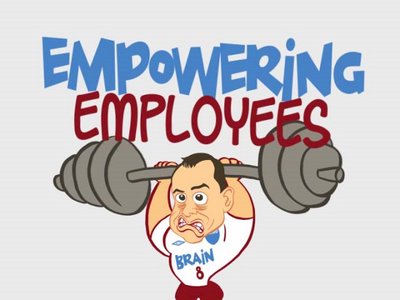 “Empower your people” — goes one of the imperatives for effective leadership.
“Empower your people” — goes one of the imperatives for effective leadership.
It means giving workers and staff the freedom to take initiatives, do things their own way with little or no guidance, decide for themselves or participate in decision making.
Having empowered people working for an entrepreneur frees him of day-to-day chores and consequently allows him time to devote to more crucial management responsibilities like planning and new product development, not to mention time for himself and his family.
Empowered employees are highly-motivated people who give their best to the company and are loyal and committed. It allows a business to retain its trained and experienced people. Empowered workers are the cogs that make a company dynamic and productive.
Entrepreneurs share their transition from “do-it-all” leaders to managers who delegate to and trust their people and being rewarded in many ways:
Case 1: Learning to trust and delegate
Maldwyn de Pano, owner-manager, of Design, used to do 80 per cent of the work in his printing shop.
His people used to be scared to take initiatives. “One wrong move and they’d get hell from me. No one dared decide for himself because that is how I wanted it to be.”
He used to tell his workers to their face: “Just use your hands; let me do the thinking.”
|
It dawned on him gradually he was doing something wrong. “If I micro-managed and a mistake resulted, I couldn’t correct it by doing the same thing again. I had to do it differently next time.” |
Nowadays, before a major project begins, he calls in his staff—the account executives, artists, production managers. “We sit together, set goals together, anticipate problems together.”
He has set up autonomous units, each authorized to make decisions.
“Dati ako ang bida. Ngayon sila na.” He now believes even those at the base of the organizational pyramid has something important to contribute. “Bawat isa, may alam na hindi ko alam gawin.”
He has learned to let go, to let his people make their own mistakes. “I can now rationalize that if a mistake happens there’s a reason for it.” Even if he loses a client or project, he is positive there is something better in the works.
Case 2: Fostering open communication and rewarding improvement
Armand Reyes, an engineer and contractor, has a similar experience.
He used to be a stern taskmaster who was the terror of his people because he would dress them down even in public if they made costly mistakes .
When he learned to relax, he started communicating with them openly. He soon realized his foremen and even the peon at the base of the totem pole had something to contribute and that he should listen to them and listen closely.
“I scheduled weekly meetings with them so they will have a regular venue not only for progress reporting but also for ventilating their thoughts, observations, and suggestions. They could call me on the phone any time, if they are in the construction sites and I am elsewhere.”
This way, his workers get clear direction and at the same time feel they are making a difference to the company.
Reyes has also put in place reward systems for employee contributions and self-improvement in the form of a a year-end profit sharing.
He would often sponsor his workers’ week-end drinking bash, providing them with flowing drinks and plenty of pulutan. He would share a drink with them for an hour or so, where talk could go anywhere from work to family to kalokohan. Then, he leaves them to themselves “so they can enjoy to the max without restraint.”
Image from: www.employeeengagementadvisor.com
